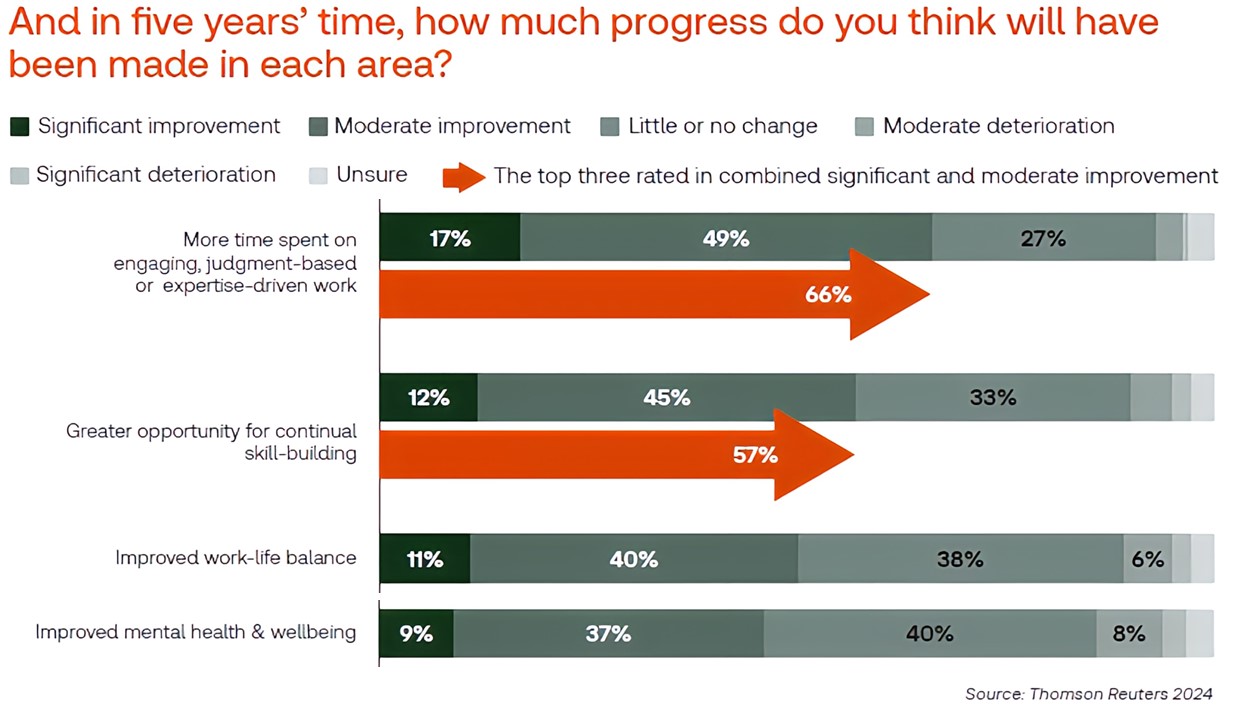Generative AI will inevitably impact law firm staffing, pricing, and client relationships and the work to prepare needs to start now
Law firms enjoyed robust financial performance in the second quarter of this year, as measured by the Thomson Reuters® Institute Law Firm Financial Index (LFFI), as all metrics pointed towards a potentially even brighter future for law firms.
Perhaps the most notable trend we’re seeing is in productivity, as measured by hours worked per lawyer, which saw its first year-over-year gains in three years. This issue of productivity brings to mind the 1000-pound supercomputer that is generative artificial intelligence (GenAI) and its potential impact on law firms’ operations.
Even though the wind is currently at law firms’ backs, the impact of GenAI could significantly alter that course with additional gains in productivity and efficiency.
Most experts agree that we are still in the early stages of GenAI adoption, and it’s still too early to determine exactly how it will change how legal work is done or what its impact will be on firm’s financial metrics. Even in the near term, however, the 2024 Thomson Reuters Future of Professionals Report found that professionals predicted that over the next year, GenAI could free up 200 hours of their time. This change alone could have a significant impact on lawyers, law firms, and clients alike.
Lawyers – How will they use their time savings?
The prospect of an additional 200 hours of available time each year raises a myriad of possibilities for how lawyers could put that time to use. Interestingly, in spite of rising concerns in recent years about workloads and lawyer burnout, professionals including lawyers may be more interested in using the efficiency gains to spend more time producing quality work and working on professional development.
Two-thirds of respondents to the Future of Professionals survey (66%) said they expect to see moderate or significant improvement because of GenAI in allowing them to spend time on engaging, judgement-based, or expertise-driven work within the next five years. And more than half (57%) said they look forward to greater opportunity to engage in continual skill-building.
While lawyers appear more eager to improve the quality of their careers and work product than their work-life balance, any reduction of mental strain by automating detail-oriented, repetitive, monotonous tasks could be a huge gain against concerns about mental health in the legal industry. Better retention of lawyers and their institutional knowledge and making recruitment of new talent more attractive are all on the table for an industry trying to counter negative perceptions about the work-life balance inherent in large law firms.

Firms – Efficiency & profitability
For many law firms, the greater workflow efficiencies from GenAI could transform how legal work is performed, who conducts that work, how work is staffed, priced, and billed, and much more. And an additional 200 work hours represents additional potential billable time equaling hundreds of thousands of dollars in revenue-generating potential for each lawyer, every year.
However, it’s not quite that simple. Much of the interest in GenAI is because of its efficiency gains. Routine or repetitive tasks can be performed in a fraction of the time that is normally required, meaning in part, that certain work could be assigned to more junior lawyers or paralegals with AI assistance.
In this way, GenAI could dramatically shift law firm cost structures. Jason Winmill, Chair of the Buying Legal Council, predicts for a large segment of legal work, such as certain routine employment matters, real estate transactions, and IP procedural work, the number of professional service hours needed to complete these matters could collapse.
However, other practices, such as high-end litigation and high-stakes complex M&A transactions, could actually see work volumes expand as lawyers’ time is freed up to focus on higher-value legal work, such as crafting more effective legal documents, determining better litigation strategies, lowering legal risk, and securing superior legal outcomes for clients. Watching hours worked by practice — LFFI’s demand metric — over the next few years could give us clues on how and where these developing work trends could start taking place.
How law firms will adjust their staffing levels and matter pricing strategies promises to present significant challenges. Indeed, the greater use of alternative fee arrangements is almost inevitable as GenAI use would mean that the work needed to complete certain matters will become increasingly detached from the traditional metric of lawyers’ billable hours. In turn, that could force firms to re-evaluate lawyer performance measurements and traditional compensation models.
The key to all this will be how law firms can take the productivity and efficiency gains from GenAI and leverage them into greater profitability.
Clients – Changing relationships with outside counsel
Lastly, GenAI will alter both how corporate law departments perform legal work as well as how they interact with their outside counsel.
Indeed, GenAI could compel law departments to bring more work in-house as efficiency gains increase the department’s capacity for conducting legal work. In addition, AI could help these departments expand their capabilities into new areas of expertise.
Not surprisingly, it will also impact their relationship with their outside legal counsel. As firms are able to complete tasks in less time, GCs may seek to renegotiate matter pricing. That could involve a combination of sharing cost savings, using value pricing to better reflect the worth of the work performed, and leveraging alternative fee arrangements.
There is also the possibility that law departments could include AI capabilities in their screening of outside counsel firms, adding it to their requirements that their chosen firms must use certain AI tools when working on their matters.
Up in the air
The only certainty about GenAI is that change is coming, potentially very quickly. Every day, the picture of what this means for how legal work will be done, and the impact on the business models of law firms and their clients becomes slightly clearer. However, despite all the recent discussions, GenAI is still relatively new. No one knows yet exactly how lawyers, law firms, and clients are going to respond to and utilize GenAI technology. Like any revolutionary technology before it, GenAI’s path will be heavily influenced by those who adopt the technology first — and those first-movers also will be best positioned to capture more of the technology’s early benefits.
Of course, it would be prudent for all legal industry stakeholders to begin exploring these questions now, ahead of all the changes. Given GenAI’s potential to rapidly transform or even disrupt the legal industry, being prepared in anticipation of these changes — even if it requires mid-course corrections later on — may be preferable to reacting later and potentially being caught flat-footed.
Particularly for law firms, with their financial outlook trending upward according to the Q2 LFFI Report, there may not be a better time to start looking ahead and positioning themselves to benefit from the upcoming technological disruption.
You can download a full copy of the Thomson Reuters® Institute Q2 Law Firm Financial Index report here.








